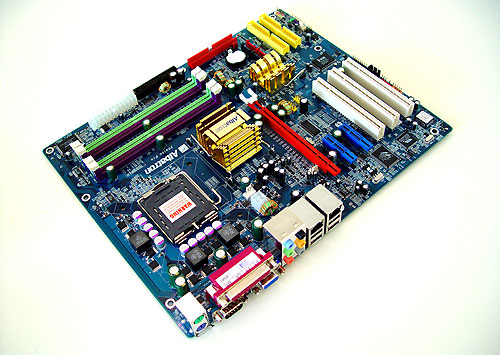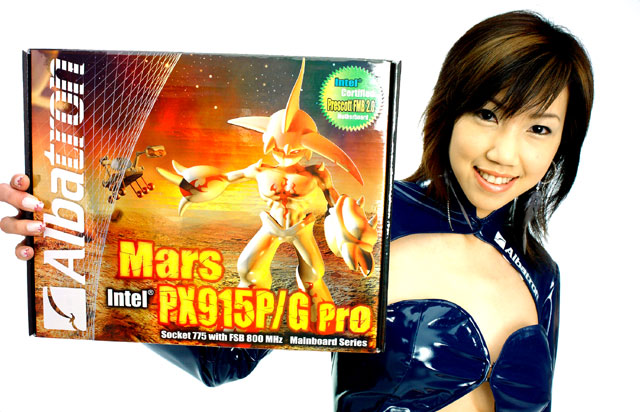Page 2
The mainboardWe'll explain the details of the mainboard in our photo shoot, as we'll walk you through the product. Yet I need to start with this, the layout of Albatron's PX915P/G Pro is really clean. Everything seems to be in the right place and is nicely color coded to prevent any confusion. Of course the mainboard itself is colored in blue, Gigabyte's Albatron's house color. What will immediately catch your attention is that fact that both the north and south bridge have a passive heatsink on it. Next to that you'll immediately notice the two small blue PCI-Express x1 slots as they are weird to see, if you look at a 915 board for the first time that is. As you can see the DDR slots are for DDR1 (common DDR memory), Albatron could have opted to go for DDR2 or even a mix of both formats. Right now DDR1 is mainstream and DDR2 still a bit to expensive. Performance wise at this very moment it really does not make a huge difference at all.

Perspective view of the mainboard. As you can immediately observe, a stylish blue PCB. You'd almost think that's a Gigabyte mainboard eh? ;)
The PX915P/G Pro's chipset has the Intel 915G North Bridge and ICH6 South Bridge. While 915G MCH really isn't Intel's biggest flagship Prescott North Bridge, it isn't all that much slower than the 925x series. Quite honestly, the performance between Intel's 915G and 925X is well... basically nothing and certainly nearly impossible to detect during real world usage. Albatron includes Intel's South Bridge, the ICH6. Personally I ws hoping for the ICH6R as that is a slightly more mature feature as it contains important additional RAID features. But hey, this is more than sufficient with high quality audio. When combined with the right codec, it makes no less than 8 channel sound available, in this case High Definition 8-channel sound through Realtek's HD ALC880 codec. 7.1 channels at 24-bit. Not bad, not bad at all.
Anyway, the 915G MCH houses an integrated graphics accelerator as well as the PCI-e and memory controllers.
When you look at the CPU position (775) you'll of course notice the new Socket 775, personally I hate Socket 775 ... I already had a Gigabyte mainboard with damaged pins and as a result a damaged 3.6 GHz Intel Pentium 4 (pssht don't tell Intel okay?), next to that the Prescott 3.6 GHz CPU (800Mhz FSB) idles at a 70 Degrees C temperature, really ridiculous. Anyway back to the socket 775, as you can observe is is surrounded by multiple transistors, they are not a problem for any heatsink, it won't cause any problems.
Now have a look at that 24-pin power connector... that's right 24 pins. This is new, when you look at your PSU you'll notice a 20 pin connector. Don't worry, it'll still fit, yet 4 pins will be empty. Future PSU's will have 24 pins. BTW small warning, don't even think about trying to connect the additional 4-pin connector that your PSU supplies on there! That still has its own socket on the mainboard.
Integrated into the mainboard is a graphics solution that Intel calls GMA 900 (Graphics Media Accelerator). Although really slow, it's actually capable of handling DirectX 9. Integrated solution in terms of graphics are not really what we guru's are after, I mean we are the hardcore gamers right?
Graphics Media Accelerator 900 Third-generation Graphics Core
- 256-bit graphics core
- 8/16/32 bpp
- Up to 8.5 GB/sec memory bandwidth
- 1.3 GP/sec and 1.3 GT/sec fill rate
- 224MB maximum video memory
- 2048x1536 at 85 Hz maximum resolution
- Dynamic Display Modes for flat-panel and wide-screen support
- Operating systems supported: Microsoft Windows XP, Windows 2000, Linux-compatible (Xfree86 source available)
- Up to 4 pixels per clock rendering
- Microsoft DirectX 9 Hardware Acceleration Features:
- Pixel Shader 2.0
- Volumetric Textures
- Shadow Maps
- Slope Scale Depth Bias
- Two-Sided Stencil
- Microsoft DirectX 9 Vertex Shader 2.0 and Transform and Lighting supported in software through highly optimized Processor Specific Geometry Pipeline (PSGP)
- DirectX Texture Decompression
- OpenGL 1.4 support
- 400 MHz DAC frequency for up to 2048x1526 resolution for both analog and digital displays
- Two Serial Digital Video Out (SDVO) ports for flat-panel monitors and/or TV-out support via Advanced Digital Display 2 (ADD2) cards
- Multiple display types (LVDS, DVI-I, DVI-D, HDTV, TV-out, CRT) for dual monitor capabilities
- Hardware motion compensation support for DVD playback
- HDTV 720p and 1080i display resolution support
- 16x9 Aspect Ratio for wide screen displays
- Up and Down Scaling of Video Content
- High Definition Content Decode
- 5x3 Overlay Filtering
- Hardware Motion Compensation support for DVD playback

Now then, which one was from Mars again ?
